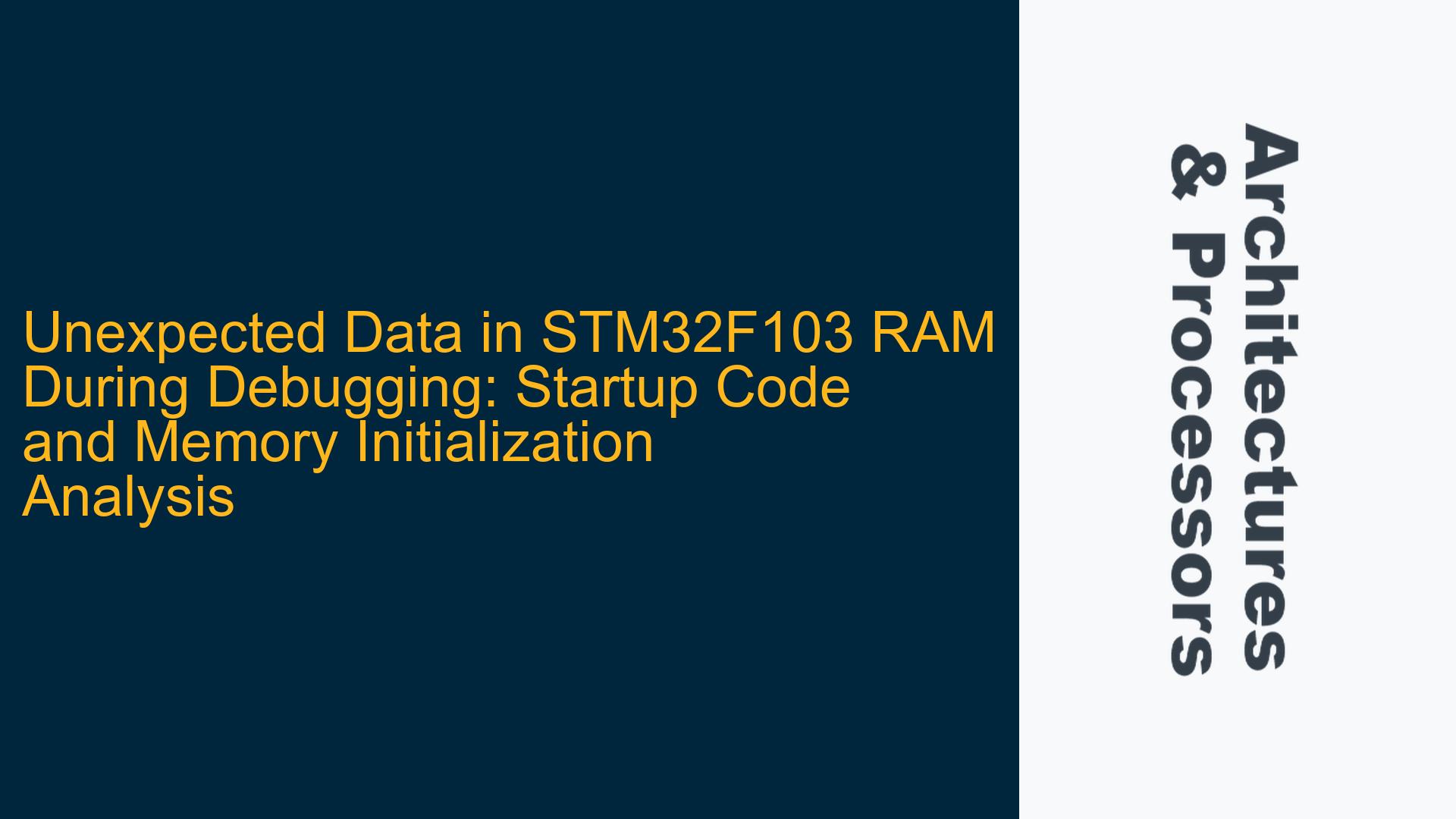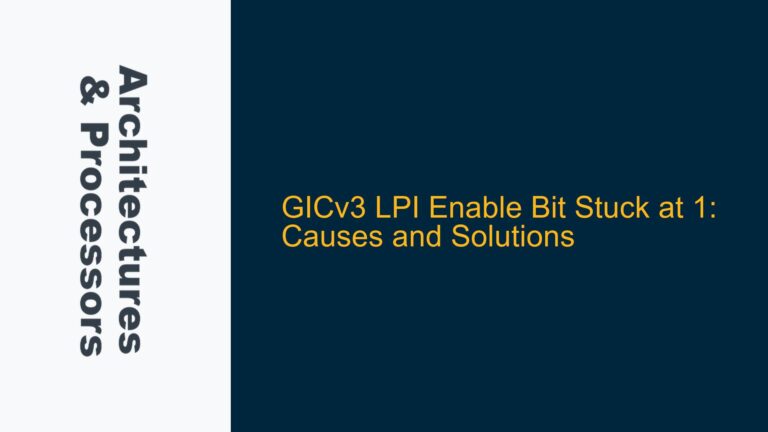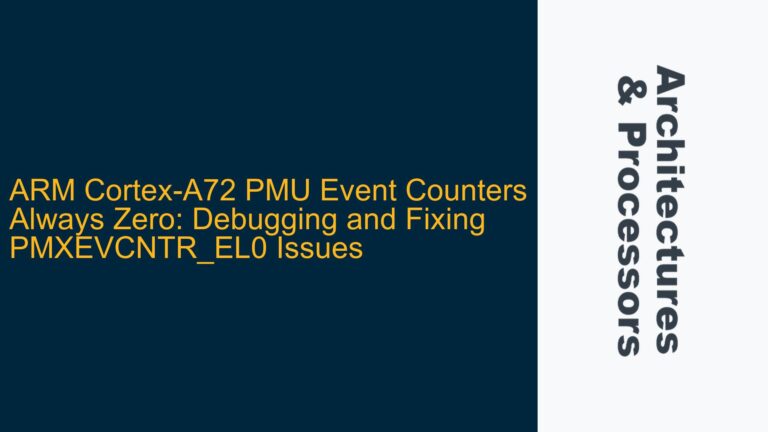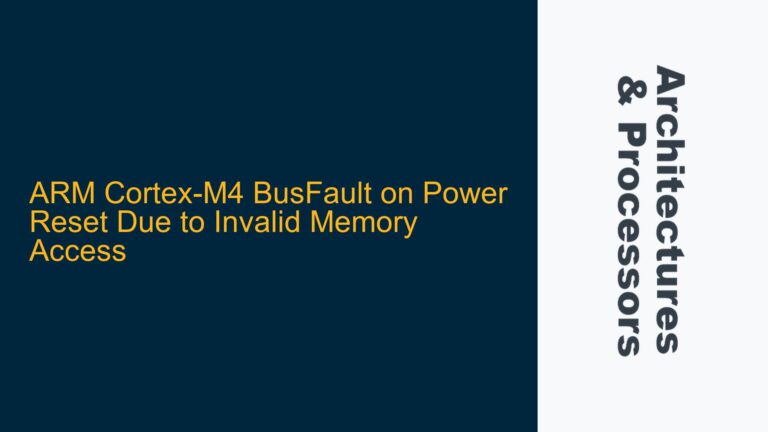STM32F103 RAM Initialization Anomalies During Debugging
When working with the STM32F103 microcontroller, a common issue arises during debugging where unexpected data appears in the RAM at address 0x20000000 even before the application code begins execution. This phenomenon is particularly noticeable when using an ST-Link debugger, as opposed to simulation mode in Keil. The RAM appears to contain pre-existing data, followed by a block of 0xFF values, which contradicts the expected behavior of a freshly initialized RAM region. This issue is often tied to the startup code and memory initialization process, which is responsible for copying data from Flash to RAM and setting up the memory environment before the main application runs.
The STM32F103 microcontroller, based on the ARM Cortex-M3 architecture, relies on a well-defined startup sequence to initialize its memory and peripherals. This sequence includes copying initialized data from Flash to RAM, zero-initializing the .bss section, and setting up the stack and heap. However, discrepancies between simulation and actual hardware debugging can lead to confusion, especially when the RAM contents do not match expectations. Understanding the underlying mechanisms of memory initialization, startup code execution, and debugger behavior is crucial to diagnosing and resolving this issue.
Flash-to-RAM Data Copy and Startup Code Execution
The unexpected data in the STM32F103 RAM during debugging is primarily caused by the execution of the startup code, which is responsible for initializing the microcontroller’s memory and peripherals. The startup code, often provided by the toolchain or generated by the IDE, performs several critical tasks before the main application code begins execution. One of these tasks is copying initialized data from Flash to RAM. This data includes global and static variables that have been explicitly initialized in the source code.
The startup code typically begins execution at the reset handler, which is the first function called after a reset event. The reset handler initializes the stack pointer, copies the .data section from Flash to RAM, and zero-initializes the .bss section. The .data section contains initialized global and static variables, while the .bss section contains uninitialized global and static variables. The startup code ensures that the RAM is properly initialized before the main application code starts running.
In the case of the STM32F103, the startup code may copy data from Flash to RAM at address 0x20000000, which explains why the RAM appears to contain pre-existing data during debugging. The block of 0xFF values that follows the initialized data is likely the result of the startup code zero-initializing the .bss section. The 0xFF pattern is often used by debuggers to represent uninitialized memory, which can be misleading if not properly understood.
The discrepancy between simulation and actual hardware debugging arises because the simulation environment may not fully replicate the behavior of the startup code and memory initialization process. In simulation mode, the RAM may appear to be empty or uninitialized, while in actual hardware debugging, the RAM will contain the data copied from Flash by the startup code. This difference can lead to confusion, especially when debugging memory-related issues.
Diagnosing and Resolving RAM Initialization Issues
To diagnose and resolve the issue of unexpected data in the STM32F103 RAM during debugging, it is essential to understand the startup code and memory initialization process. The following steps can help identify the root cause of the problem and ensure that the RAM is properly initialized before the main application code begins execution.
Step 1: Review the Startup Code
The first step in diagnosing the issue is to review the startup code provided by the toolchain or generated by the IDE. The startup code is typically located in a file named startup_stm32f103.s or similar, and it contains the reset handler and other initialization routines. The reset handler is responsible for initializing the stack pointer, copying the .data section from Flash to RAM, and zero-initializing the .bss section.
In the startup code, locate the section that copies the .data section from Flash to RAM. This section will typically involve loading the start and end addresses of the .data section from the linker script, and then using a loop to copy the data from Flash to RAM. Ensure that the addresses and sizes used in this section are correct and match the linker script.
Next, locate the section that zero-initializes the .bss section. This section will typically involve loading the start and end addresses of the .bss section from the linker script, and then using a loop to fill the .bss section with zeros. Again, ensure that the addresses and sizes used in this section are correct and match the linker script.
Step 2: Verify the Linker Script
The linker script defines the memory layout of the STM32F103 microcontroller, including the locations of the .data and .bss sections in RAM. The linker script is typically named STM32F103.ld or similar, and it is used by the linker to assign addresses to the various sections of the application code.
In the linker script, locate the sections that define the .data and .bss sections. The .data section should be defined to start at the beginning of the RAM (0x20000000), and the .bss section should be defined to follow the .data section. Ensure that the addresses and sizes of these sections are correct and match the startup code.
If the linker script is not correctly configured, the startup code may copy data to the wrong location in RAM or fail to initialize the .bss section properly. This can lead to unexpected data in the RAM during debugging.
Step 3: Debug the Reset Handler
To further diagnose the issue, set a breakpoint at the beginning of the reset handler in the startup code. When the debugger stops at this breakpoint, inspect the contents of the RAM at address 0x20000000. The RAM should be empty or contain random data at this point, as the startup code has not yet copied the .data section from Flash to RAM.
Step through the startup code and observe the changes in the RAM as the .data section is copied from Flash to RAM and the .bss section is zero-initialized. This will help you verify that the startup code is correctly initializing the RAM and that the addresses and sizes used in the startup code match the linker script.
Step 4: Check for Debugger Artifacts
In some cases, the unexpected data in the RAM may be caused by artifacts introduced by the debugger. For example, the debugger may fill uninitialized memory with a specific pattern (such as 0xFF) to help identify uninitialized variables. This can be misleading if not properly understood, as it may appear that the RAM contains pre-existing data when in fact it is simply being filled by the debugger.
To check for debugger artifacts, disable any memory initialization options in the debugger settings. For example, in Keil uVision, you can disable the "Initialize Memory" option in the debugger settings to prevent the debugger from filling uninitialized memory with a specific pattern. This will allow you to see the actual contents of the RAM during debugging.
Step 5: Validate the Scatter File
The scatter file is used by the linker to define the memory layout of the application code, including the locations of the .data and .bss sections in RAM. The scatter file is typically named STM32F103.sct or similar, and it is used by the linker to assign addresses to the various sections of the application code.
In the scatter file, locate the sections that define the .data and .bss sections. The .data section should be defined to start at the beginning of the RAM (0x20000000), and the .bss section should be defined to follow the .data section. Ensure that the addresses and sizes of these sections are correct and match the startup code and linker script.
If the scatter file is not correctly configured, the linker may assign incorrect addresses to the .data and .bss sections, leading to unexpected data in the RAM during debugging.
Step 6: Verify the Flash Contents
Finally, verify the contents of the Flash memory to ensure that the .data section is correctly stored in Flash and will be copied to RAM by the startup code. Use the debugger to inspect the Flash memory at the addresses defined in the linker script for the .data section. The Flash memory should contain the initialized data that will be copied to RAM during startup.
If the Flash memory does not contain the expected data, there may be an issue with the compilation or linking process. Ensure that the source code is correctly compiled and linked, and that the initialized data is correctly stored in Flash.
Conclusion
The issue of unexpected data in the STM32F103 RAM during debugging is primarily caused by the execution of the startup code, which copies initialized data from Flash to RAM and zero-initializes the .bss section. By reviewing the startup code, verifying the linker script, debugging the reset handler, checking for debugger artifacts, validating the scatter file, and verifying the Flash contents, you can diagnose and resolve the issue to ensure that the RAM is properly initialized before the main application code begins execution. Understanding the memory initialization process and the behavior of the debugger is crucial to successfully debugging memory-related issues in embedded systems.






